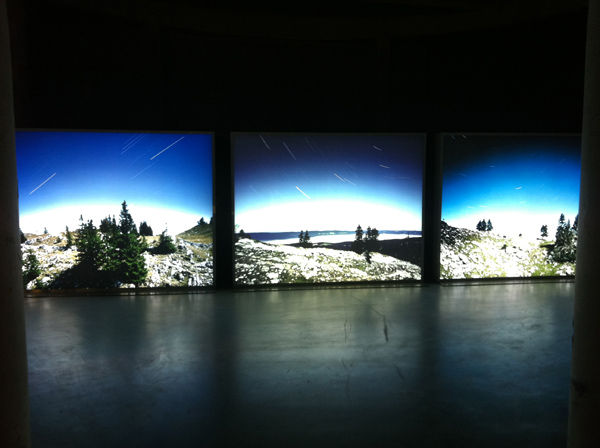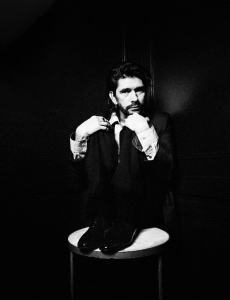- Kat Phan visits Paris to celebrate the opening of Audemars Piguet’s exclusive exhibition at Palais de Tokyo, to mark the 40th anniversary of its iconic Royal Oak timepiece..
 Gallery View: Courtesy of Sebastien Leon Agneessens
Gallery View: Courtesy of Sebastien Leon Agneessens
ast month the contemporary art gallery Palais de Tokyo in Paris played host to a unique exhibition featuring design, photography, sound and film to celebrate the 40th birthday of Audemars Piguet’s (AP) iconic timepiece, the Royal Oak. Using the Vallée de Joux (the birthplace of Haute Horologie in Switzerland) as a source of inspiration for the exhibition’s backdrop, the show featured 100 Royal Oak watches interspersed among mesmerising installations by the exhibition’s curator Sebastien Leon Agneessens, visual artist Quayola and photographer Dan Holdsworth.
- For many watch enthusiasts, the Royal Oak remains one of the first luxury sports timepieces that marked a quartz revolution. In the early days, the design was considered to be an anomaly in the industry because all of its competitor brands worked with materials such as gold and platinum opposed to stainless steel, which was not perceived to be a precious metal at the time. The case sizes of other watches were also smaller, averaging around 35-36 millimetres, so the launch of the bold 39 millimetre Royal Oak case was considered to be enormous in comparison. Despite horology purists sneering, the watch went on to become a success and a key item in the AP collection.
The exhibition at the Palais de Tokyo charted the evolution of the Royal Oak, taking visitors on a journey from the launch of its very first model in 1972, designed by Gérald Genta (who passed away last year, aged 80), to the morerecent models unveiled at the Salon International de la Haute Horologie in Geneva earlier this year. Highlights included the Royal Oak Offshore, an even chunkier version than the original model produced in 1992 which has gone on to outsell its precursor, a uniquely commissioned piece designed for Cirque de Soleil founder Guy Laliberté that followed him into space in 2009, a bespoke Royal Oak Offshore “End of Days” writstwatch worn by Arnold Schwarzenneger in his movie of the same name, and a range of wrist and pocket watches predating the Royal Oak.
Whilst the watches have retained the key characteristics – such as its octagonal bezel, eight hexagonal screws made of white gold and tapered bracelet – of the earlier model throughout the years, the vast collection on show is a reminder of AP’s malleability, and its ability to keep the brand “fresh”, without deviating too far away from the foundation upon which it was built.
Auguste Rodin’s The Thinker,
gallery view. Courtesy
of Quayola
ith an emphasis on the origins of the Royal Oak and how it has progressed through time, the three artists worked collaboratively to recreate the Vallée de Joux in the Swiss Jura mountains, using its serene yet rugged landscapes and hostile climate as stimuli in their interpretations. Since 1875, the village of Le Brassus has become the home of AP where farmers worked on the land during the summer and honed their craftsmanship in blacksmithing and cutting precious stones in the winter, which has developed into the laser beam precision-like watch-making skills that they have acquired today.
 Above right: Vallée de Joux, Dan Holdsworth
Above right: Vallée de Joux, Dan HoldsworthOn entering the exhibition, you are greeted by Agneessens’ metallic tubular sticks of differing heights, to symbolise forests of the valley area, which are scattered throughout the venue. Permeating the open plan space which is divided into invisible segments is a soundtrack, also composed by Agneessens, comprising of the sounds of cow bells, birds, ice cracking in the sun and watch mechanisms, taken from recordings in Le Brassus, which have been stretched beyond recognition into dream-like, trance-inducing melodies. The watches are showcased in angular and multi-faceted vitrines where the watches stand erect on slender chopstick-like structures poking out from the dark reflective metal surfaces inside, symbolising the modern stainless steel elements of the watch. This is contrasted with the rustic wooden exterior, made from trees which previously inhabited Le Brassus, juxtaposing AP’s modern aesthetic with its long-standing tradition and humble origins. “The whole landscape is inspired by the valley; the way the watches are shown is like the way the land works – the valley in Le Brassus is surrounded by mountains and it’s very rocky; the landscape’s very dramatic,” he explains.
- The show also features two sets of triptychs by Holdsworth, capturing the ancient forests and glacial topography of the Vallée de Joux, with landscapes emerging from the mist with cosmic projections, representing AP’s historic technology emergence out of the valley. In this panoramic format, he explores the link between nature, man and his creations: “I was very interested in examining the idea of time, but also the nature of this ancient glacial valley and the way in which it acts like a time capsule. It’s still an ancient, primordial landscape so I wanted to explore this continuum into space, to have long exposures where you see the star trails, to have that continuity from the valley – almost like a future projection of the valley in time.”
 Vallée de Joux, Dan Holdsworth
Vallée de Joux, Dan Holdsworth
- The final installation is a film by digital artist Quayola, which forms part of a larger body of work called The Strata Series, essentially a study and celebration of matter and its continuous transformation through classical art, 1970s sculpture, architecture, and contemporary digital aesthetics. “I’m fascinated by how matter can present itself in many different forms, from geological processes to things that happened over millions of years ago under the crust,” he says.
“I was very interested in examining the idea of time, but also the nature of this ancient glacial valley and the way in which it acts like a time capsule.”
In Quayola’s films, he digitally deconstructs objects in their final state to a cube of matter, with the overall aim of creating something new. This is demonstrated in his film of Auguste Rodin’s famous sculpture The Thinker where he compares Rodin’swork with the birth and constant evolution of the Royal Oak: “He studied the rules of academia, mastered them and then broke them, creating something that was truly avant-garde whilst still managing to bridge the gap between the classical and the modern.”
The exhibition has already appeared in New York, Milan and Paris, and will continue in Beijing, Singapore and Dubai as part of the year-long celebrations to mark the Royal Oak’s 40th anniversary.
For more information visit audemarspiguet.com
Subscribe to Port Magazine annually and receive each issue to your door.
Get PORT in print




